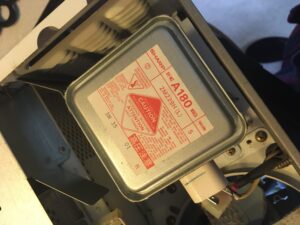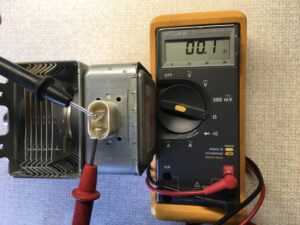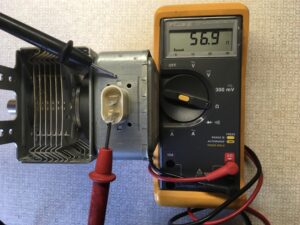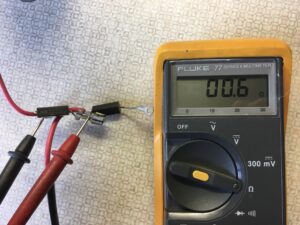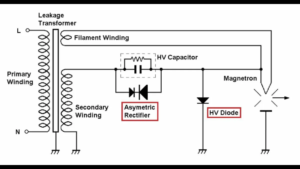My Sharp R-3G54(B)T Microwave Oven, having survived careful but frequent use over THIRTY YEARS, finally passed away a couple of days ago. It was well built in Thailand in 1993…I’ve repaired a few minor problems over recent years, but this time it was terminal, although it didn’t need to be.
WARNING: The voltages inside a microwave oven can kill you. Do not, under any circumstances, attempt to repair or test a microwave oven unless you know what you are doing. Should you decide to follow these instructions, you do so entirely of your own volition.
If you’d like the circuit diagram (schematic) for the Sharp R-3G54(B)T, there’s a copy on the inside of the outer case of your microwave…or click here.
On Monday morning this week, I went to make my porridge as usual. The microwave ran for about two seconds then died…no clock, no lights, no nothing. After unplugging the microwave from the wall, I removed the cover to find the main fuse had blown. With a multimeter, I checked the voltage across the 2,000V capacitor and it was zero. I then checked the magnetron and diodes to find both were faulty.
The diode set is available on eBay for a few pounds and I assumed that I would be able to find a replacement magnetron; it is a Sharp device, part number 2M229H(L). The part number is 2M229H and the (L) is the configuration i.e. the way it is fixed into the oven. I was able to find the (A) variant in the USA but procuring it would have been uneconomical.
There was not a single 2M229H or equivalent that would fit in the space available, with inline air flow, anywhere in Europe.
Reluctantly, the old Sharp has been recycled and I bought a new and surprisingly similar Panasonic.
Initial Safety Checks
So, if your microwave has died and you know what you’re doing, this is how to test the bits that matter. First of all, unplug your microwave from the wall and leave it for ten minutes to allow any high voltages stored internally to discharge. Remove the outer cover and locate the main fuse – if it hasn’t blown, check the fuse in your mains plug, and if that hasn’t blown the fault may well be something other than the magnetron. Next, locate the high voltage capacitor; it’s normally about four inches long and like a squashed aluminium cylinder with spade connectors at one end.
Measure the voltage across the two spade connectors and ensure it is zero; if it isn’t you should leave the oven to discharge for longer, unless you know how to discharge the capacitor manually.
Testing the Magnetron
Most magnetrons are similar, with two shrouded spade connectors which feed heater voltage and around 1,500V to the magnetron. Carefully disconnect the two spade connectors, noting which one goes where. You will now need a multimeter set to the low resistance range.
Connect your multimeter across the two spade connectors and you should get a reading of less than one ohm. If you do, then the heater for the magnetron is sound…if you get a high reading, it’s defective.
Next, set your multimeter to a high resistance range and measure the resistance between either of the two spade terminals, and the metal of the magnetron body. You should get a reading of infinity or ‘open circuit’.
If you don’t, and usually a faulty magnetron will show a very low reading, then you have located the fault…you need a new magnetron, as in this case.
Testing the two diodes
Microwave ovens have two diodes in their power supply, a high voltage rectifier to provide around 1,500V DC to run the magnetron, and an asymmetric diode pair, used to protect the oven in the event of a magnetron failure; the device prevents the build up of excessively high voltage across the capacitor and transformer by blowing the main fuse.
Here’s the technical explanation from a data sheet:
‘The Asymmetric Rectifier or Short Protector, as it is sometimes called, is included in the circuit to prevent damage to the high voltage transformer and high voltage capacitor, in case of a short circuit occurring on the magnetron or high voltage diode. The short protector will cause the line fuse to blow in the above fault conditions.
The device will not conduct in any direction, therefore has no effect on the circuit under normal operating conditions. The peak inverse breakdown voltage of D1 is 6kV and D2 is say 1.8kV.
Under fault conditions when a short circuit occurs the peak inverse voltage of D2 will be exceeded, this will cause the diode to go short circuit. This in turn will cause a very high forward current through D1, causing it to go short circuit also. This will cause a dead short to appear across the high voltage transformer secondary, which will blow the line fuse, removing power to the high voltage transformer.’
You can’t test the high voltage diode using a modern multimeter as its forward voltage drop is greater than the voltage supplied by the multimeter test. But if you test the asymmetric diode it should read open circuit both ways. If your magnetron has failed and the main fuse was blown, chances are this diode is short circuit…as shown in the picture. Make sure the diode(s) are removed from the circuit before testing.
If this asymmetric diode has failed, just replace the pair. Frankly, even if they measure correctly, I’d change them after a magnetron failure.
What about the capacitor
Check that on a high resistance range using your multimeter across the two spade terminals, with nothing else connected. It should infinity, read open circuit, both ways; the capacitor will need to charge so give it a couple of seconds after connecting your meter. If you have a capacitance meter, you can check that too. Here’s a basic circuit showing the essential parts of a microwave oven; D1 is the left side of the asymmetric diode and D2 is to the right.
I hope that helps you save another microwave oven from the tip, sadly I couldn’t this time.
How long do microwave ovens last? Well the old ones seem to outlast the modern ones which are built down to a price in China. My mum and dad bought an early Sharp R-6460E microwave oven from Makro, back in the 1970s. It was used every day and my mum was still using it in 2013; so probably around 40 years, and mine lasted 30.
Here’s the official line on modern microwaves: ‘With normal usage for an average family and good maintenance, a microwave often lasts for 7 to 8 years. If the microwave is used less frequently by a single person or a couple and is well-maintained, the lifespan can increase to up to 10 years.’

